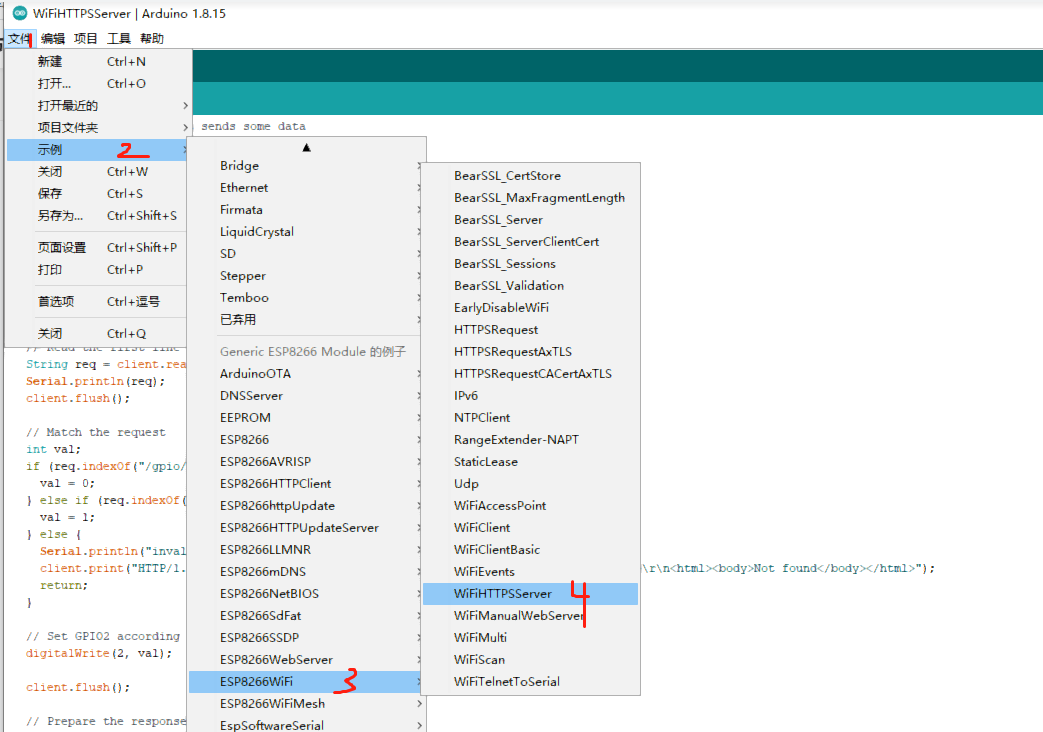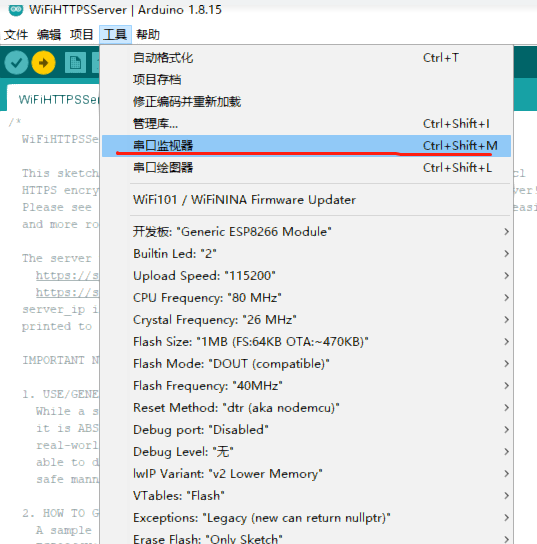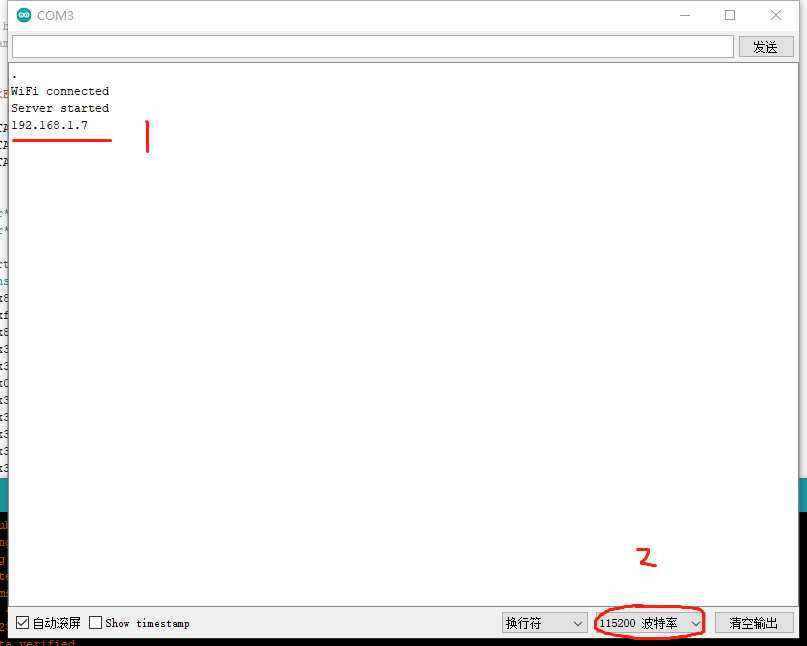整个原理就是,ESP8266 会去链接WIFI,通过WIFI账号和密码,然后,它自己称为一个服务器,就可以直接展现出来网页。
手机端,电脑端可以直接连接这个页面。
代码如下,也可以直接从Arduino打开 ,如下

具体代码如下:
#include <ESP8266WiFi.h>
#ifndef STASSID
#define STASSID "My home"
#define STAPSK "1213141516"
#endif
const char* ssid = STASSID;
const char* password = STAPSK;
// The certificate is stored in PMEM
static const uint8_t x509[] PROGMEM = {
0x30, 0x82, 0x01, 0x3d, 0x30, 0x81, 0xe8, 0x02, 0x09, 0x00, 0xfe, 0x56,
0x46, 0xf2, 0x78, 0xc6, 0x51, 0x17, 0x30, 0x0d, 0x06, 0x09, 0x2a, 0x86,
0x48, 0x86, 0xf7, 0x0d, 0x01, 0x01, 0x0b, 0x05, 0x00, 0x30, 0x26, 0x31,
0x10, 0x30, 0x0e, 0x06, 0x03, 0x55, 0x04, 0x0a, 0x0c, 0x07, 0x45, 0x53,
0x50, 0x38, 0x32, 0x36, 0x36, 0x31, 0x12, 0x30, 0x10, 0x06, 0x03, 0x55,
0x04, 0x03, 0x0c, 0x09, 0x31, 0x32, 0x37, 0x2e, 0x30, 0x2e, 0x30, 0x2e,
0x31, 0x30, 0x1e, 0x17, 0x0d, 0x31, 0x37, 0x30, 0x33, 0x31, 0x38, 0x31,
0x34, 0x34, 0x39, 0x31, 0x38, 0x5a, 0x17, 0x0d, 0x33, 0x30, 0x31, 0x31,
0x32, 0x35, 0x31, 0x34, 0x34, 0x39, 0x31, 0x38, 0x5a, 0x30, 0x26, 0x31,
0x10, 0x30, 0x0e, 0x06, 0x03, 0x55, 0x04, 0x0a, 0x0c, 0x07, 0x45, 0x53,
0x50, 0x38, 0x32, 0x36, 0x36, 0x31, 0x12, 0x30, 0x10, 0x06, 0x03, 0x55,
0x04, 0x03, 0x0c, 0x09, 0x31, 0x32, 0x37, 0x2e, 0x30, 0x2e, 0x30, 0x2e,
0x31, 0x30, 0x5c, 0x30, 0x0d, 0x06, 0x09, 0x2a, 0x86, 0x48, 0x86, 0xf7,
0x0d, 0x01, 0x01, 0x01, 0x05, 0x00, 0x03, 0x4b, 0x00, 0x30, 0x48, 0x02,
0x41, 0x00, 0xc6, 0x72, 0x6c, 0x12, 0xe1, 0x20, 0x4d, 0x10, 0x0c, 0xf7,
0x3a, 0x2a, 0x5a, 0x49, 0xe2, 0x2d, 0xc9, 0x7a, 0x63, 0x1d, 0xef, 0xc6,
0xbb, 0xa3, 0xd6, 0x6f, 0x59, 0xcb, 0xd5, 0xf6, 0xbe, 0x34, 0x83, 0x33,
0x50, 0x80, 0xec, 0x49, 0x63, 0xbf, 0xee, 0x59, 0x94, 0x67, 0x8b, 0x8d,
0x81, 0x85, 0x23, 0x24, 0x06, 0x52, 0x76, 0x55, 0x9d, 0x18, 0x09, 0xb3,
0x3c, 0x10, 0x40, 0x05, 0x01, 0xf3, 0x02, 0x03, 0x01, 0x00, 0x01, 0x30,
0x0d, 0x06, 0x09, 0x2a, 0x86, 0x48, 0x86, 0xf7, 0x0d, 0x01, 0x01, 0x0b,
0x05, 0x00, 0x03, 0x41, 0x00, 0x69, 0xdc, 0x6c, 0x9b, 0xa7, 0x62, 0x57,
0x7e, 0x03, 0x01, 0x45, 0xad, 0x9a, 0x83, 0x90, 0x3a, 0xe7, 0xdf, 0xe8,
0x8f, 0x46, 0x00, 0xd3, 0x5f, 0x2b, 0x0a, 0xde, 0x92, 0x1b, 0xc5, 0x04,
0xc5, 0xc0, 0x76, 0xf4, 0xf6, 0x08, 0x36, 0x97, 0x27, 0x82, 0xf1, 0x60,
0x76, 0xc2, 0xcd, 0x67, 0x6c, 0x4b, 0x6c, 0xca, 0xfd, 0x97, 0xfd, 0x33,
0x9e, 0x12, 0x67, 0x6b, 0x98, 0x7e, 0xd5, 0x80, 0x8f
};
// And so is the key. These could also be in DRAM
static const uint8_t rsakey[] PROGMEM = {
0x30, 0x82, 0x01, 0x3a, 0x02, 0x01, 0x00, 0x02, 0x41, 0x00, 0xc6, 0x72,
0x6c, 0x12, 0xe1, 0x20, 0x4d, 0x10, 0x0c, 0xf7, 0x3a, 0x2a, 0x5a, 0x49,
0xe2, 0x2d, 0xc9, 0x7a, 0x63, 0x1d, 0xef, 0xc6, 0xbb, 0xa3, 0xd6, 0x6f,
0x59, 0xcb, 0xd5, 0xf6, 0xbe, 0x34, 0x83, 0x33, 0x50, 0x80, 0xec, 0x49,
0x63, 0xbf, 0xee, 0x59, 0x94, 0x67, 0x8b, 0x8d, 0x81, 0x85, 0x23, 0x24,
0x06, 0x52, 0x76, 0x55, 0x9d, 0x18, 0x09, 0xb3, 0x3c, 0x10, 0x40, 0x05,
0x01, 0xf3, 0x02, 0x03, 0x01, 0x00, 0x01, 0x02, 0x40, 0x35, 0x0b, 0x74,
0xd3, 0xff, 0x15, 0x51, 0x44, 0x0f, 0x13, 0x2e, 0x9b, 0x0f, 0x93, 0x5c,
0x3f, 0xfc, 0xf1, 0x17, 0xf9, 0x72, 0x94, 0x5e, 0xa7, 0xc6, 0xb3, 0xf0,
0xfe, 0xc9, 0x6c, 0xb1, 0x1e, 0x83, 0xb3, 0xc6, 0x45, 0x3a, 0x25, 0x60,
0x7c, 0x3d, 0x92, 0x7d, 0x53, 0xec, 0x49, 0x8d, 0xb5, 0x45, 0x10, 0x99,
0x9b, 0xc6, 0x22, 0x3a, 0x68, 0xc7, 0x13, 0x4e, 0xb6, 0x04, 0x61, 0x21,
0x01, 0x02, 0x21, 0x00, 0xea, 0x8c, 0x21, 0xd4, 0x7f, 0x3f, 0xb6, 0x91,
0xfa, 0xf8, 0xb9, 0x2d, 0xcb, 0x36, 0x36, 0x02, 0x5f, 0xf0, 0x0c, 0x6e,
0x87, 0xaa, 0x5c, 0x14, 0xf6, 0x56, 0x8e, 0x12, 0x92, 0x25, 0xde, 0xb3,
0x02, 0x21, 0x00, 0xd8, 0x99, 0x01, 0xf1, 0x04, 0x0b, 0x98, 0xa3, 0x71,
0x56, 0x1d, 0xea, 0x6f, 0x45, 0xd1, 0x36, 0x70, 0x76, 0x8b, 0xab, 0x69,
0x30, 0x58, 0x9c, 0xe0, 0x45, 0x97, 0xe7, 0xb6, 0xb5, 0xef, 0xc1, 0x02,
0x21, 0x00, 0xa2, 0x01, 0x06, 0xc0, 0xf2, 0xdf, 0xbc, 0x28, 0x1a, 0xb4,
0xbf, 0x9b, 0x5c, 0xd8, 0x65, 0xf7, 0xbf, 0xf2, 0x5b, 0x73, 0xe0, 0xeb,
0x0f, 0xcd, 0x3e, 0xd5, 0x4c, 0x2e, 0x91, 0x99, 0xec, 0xb7, 0x02, 0x20,
0x4b, 0x9d, 0x46, 0xd7, 0x3c, 0x01, 0x4c, 0x5d, 0x2a, 0xb0, 0xd4, 0xaa,
0xc6, 0x03, 0xca, 0xa0, 0xc5, 0xac, 0x2c, 0xe0, 0x3f, 0x4d, 0x98, 0x71,
0xd3, 0xbd, 0x97, 0xe5, 0x55, 0x9c, 0xb8, 0x41, 0x02, 0x20, 0x02, 0x42,
0x9f, 0xd1, 0x06, 0x35, 0x3b, 0x42, 0xf5, 0x64, 0xaf, 0x6d, 0xbf, 0xcd,
0x2c, 0x3a, 0xcd, 0x0a, 0x9a, 0x4d, 0x7c, 0xad, 0x29, 0xd6, 0x36, 0x57,
0xd5, 0xdf, 0x34, 0xeb, 0x26, 0x03
};
// Create an instance of the server
// specify the port to listen on as an argument
WiFiServerSecure server(443);
void setup() {
Serial.begin(115200);
// prepare GPIO2
pinMode(2, OUTPUT);
digitalWrite(2, 0);
// Connect to WiFi network
Serial.println();
Serial.println();
Serial.print("Connecting to ");
Serial.println(ssid);
WiFi.begin(ssid, password);
while (WiFi.status() != WL_CONNECTED) {
delay(500);
Serial.print(".");
}
Serial.println("");
Serial.println("WiFi connected");
// Set the certificates from PMEM (if using DRAM remove the _P from the call)
server.setServerKeyAndCert_P(rsakey, sizeof(rsakey), x509, sizeof(x509));
// Start the server
server.begin();
Serial.println("Server started");
// Print the IP address
Serial.println(WiFi.localIP());
}
void loop() {
// Check if a client has connected
WiFiClientSecure client = server.available();
if (!client) {
return;
}
// Wait until the client sends some data
Serial.println("new client");
unsigned long timeout = millis() + 3000;
while (!client.available() && millis() < timeout) {
delay(1);
}
if (millis() > timeout) {
Serial.println("timeout");
client.flush();
client.stop();
return;
}
// Read the first line of the request
String req = client.readStringUntil('r');
Serial.println(req);
client.flush();
// Match the request
int val;
if (req.indexOf("/gpio/0") != -1) {
val = 0;
} else if (req.indexOf("/gpio/1") != -1) {
val = 1;
} else {
Serial.println("invalid request");
client.print("HTTP/1.1 404 Not FoundrnContent-Type: text/htmlrnrn<!DOCTYPE HTML>rn<html><body>Not found</body></html>");
return;
}
// Set GPIO2 according to the request
digitalWrite(2, val);
client.flush();
// Prepare the response
String s = "HTTP/1.1 200 OKrnContent-Type: text/htmlrnrn<!DOCTYPE HTML>rn<html>rnGPIO is now ";
s += (val) ? "high" : "low";
s += "</html>n";
// Send the response to the client
client.print(s);
delay(1);
Serial.println("Client disconnected");
// The client will actually be disconnected
// when the function returns and 'client' object is detroyed
}
上面的
#define STASSID "My home"
#define STAPSK "1213141516"
这些 其实是我这边的WIFI 的名字和密码
修改完之后。直接

先1生成二进制文件
然后在2,下载到你的ESP8266设备里。

第一步编译完成
第二步上传成功

最后,我们来打开我们的串口监视器

如下所示
1为 它所在的IP地址
2.为波特率,一定要选对要不然会乱码(默认的话 应该是115200)

这个时候,我们可以看到 ESP8266 的灯是亮的
直接访问 https://192.168.1.7/gpio/1 这个地址 就可以点亮灯
访问 https://192.168.1.7/gpio/0 就能关闭灯
至此,这个案例ok。
最后
以上就是碧蓝鱼最近收集整理的关于ESP8266 (Arduino) 之 WIFI HTTPS Server [web 服务器]的全部内容,更多相关ESP8266内容请搜索靠谱客的其他文章。
本图文内容来源于网友提供,作为学习参考使用,或来自网络收集整理,版权属于原作者所有。



![[Bluetooth]使用虚拟串口连接到远程蓝牙设备](https://file2.kaopuke.com:8081/files_image/reation/bcimg1.png)
![ESP8266 (Arduino) 之 WIFI HTTPS Server [web 服务器]](https://file2.kaopuke.com:8081/files_image/reation/bcimg2.png)



发表评论 取消回复